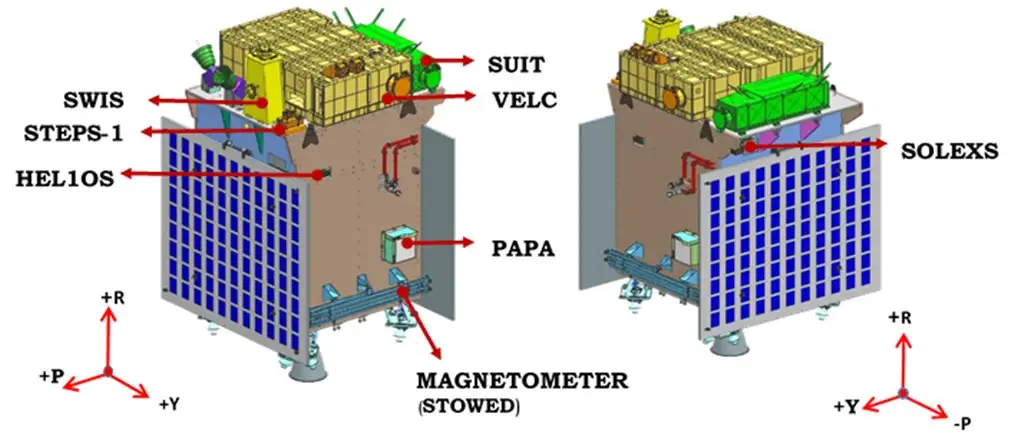In a significant leap forward for India's space exploration endeavors, the country is preparing to launch its first space-based mission dedicated to studying the Sun. Aditya L1, as it is aptly named, will be a groundbreaking endeavor that aims to unravel the mysteries surrounding our nearest star. Scheduled to be placed in a halo orbit around the Lagrange point 1 (L1) of the Sun-Earth system, approximately 1.5 million kilometers from Earth, this mission promises to provide unprecedented insights into the workings of the Sun and its influence on space weather.
Lagrange point 1 (L1) is a point of gravitational equilibrium between the Sun and Earth, located approximately 1.5 million kilometers from Earth in the Sun-Earth system. It is a stable point where the gravitational forces from the Sun and Earth balance out, allowing objects to maintain a relatively fixed position with respect to both celestial bodies.
|
One of the key advantages of Aditya L1's unique position in the L1 halo orbit is its ability to continuously observe the Sun without any occultation or eclipses. Unlike Earth-based observatories, which face limitations due to the periodic blockage of the Sun by the Moon or other celestial bodies, Aditya L1 will have an unobstructed view. This uninterrupted vantage point will allow scientists to closely monitor solar activities and their impact on space weather in real time.
Equipped with a remarkable suite of seven payloads, Aditya L1 is prepared to explore the various layers of the Sun, including the photosphere, chromosphere, and the outermost layer known as the corona. These payloads consist of electromagnetic, particle, and magnetic field detectors, enabling comprehensive observations of the Sun's dynamics.
Four of the payloads are specifically designed for direct viewing of the Sun, while the remaining three payloads will conduct in-situ studies of particles and fields at the Lagrange point L1. This combination of remote sensing and in-situ observations will provide crucial scientific data on the propagatory effects of solar dynamics in the interplanetary medium.
 Aditya-L1 Payloads:
Aditya-L1 Payloads:
Aditya L1's payloads are expected to play a pivotal role in understanding several key phenomena related to the Sun. By studying the solar upper atmosphere, including the chromosphere and corona, scientists hope to gain insights into the mechanisms behind coronal heating, coronal mass ejections (CMEs), pre-flare and flare activities, and their characteristics. The mission will also provide valuable data on the physics of the partially ionized plasma, which is essential for understanding the initiation of CMEs and flares.
Furthermore, the in-situ instruments will analyze the particle and plasma environment at the Lagrange point L1, contributing to our understanding of particle dynamics emanating from the Sun. Aditya L1 will delve into the intricacies of the solar corona and its heating mechanism, while also providing diagnostics of plasma temperature, velocity, and density in the coronal and coronal loops.
Another significant aspect of the mission is the investigation of coronal mass ejections (CMEs). Aditya L1 aims to examine the development, dynamics, and origins of these powerful eruptions of solar material. By identifying the sequence of processes occurring at multiple layers of the Sun, from the chromosphere to the extended corona, scientists hope to gain a clearer understanding of the factors leading to solar eruptive events.

In addition to the aforementioned objectives, Aditya L1 will focus on studying the magnetic field topology and measurements in the solar corona. These investigations will contribute to our understanding of the drivers behind space weather, such as the origin, composition, and dynamics of the solar wind.
The mission's payload configuration reflects its comprehensive approach to solar observations. Four remote sensing payloads will capture images and spectra of the Sun, including the Visible Emission Line Coronagraph (VELC), Solar Ultraviolet Imaging Telescope (SUIT), Solar Low Energy X-ray Spectrometer (SoLEXS), and High Energy L1 Orbiting X-ray Spectrometer (HEL1OS). These instruments will provide crucial data on various aspects of the Sun's emissions.
On the other hand, the three in-situ payloads—Aditya Solar Wind Particle Experiment (ASPEX), Plasma Analyser Package for Aditya (PAPA), and Advanced Tri-axial High-Resolution Digital Magnetometers—will focus on studying the local environment at the Lagrange point L1, analyzing solar wind particles, ions, electrons, and magnetic fields.
As Aditya L1 prepares to embark on its mission, scientists and researchers eagerly await the wealth of data it will collect. The insights gained from this ambitious endeavor will undoubtedly contribute to advancements in solar physics, space weather forecasting, and our understanding of our own star, the Sun.
India's foray into space-based solar observation with the Aditya L1 mission signals the nation's growing prowess in space exploration and research. As we embark on this new era of scientific discovery, Aditya L1 will undoubtedly pave the way for future advancements in our understanding of the Sun and its profound impact on our planet and beyond.
Questions or comments on this article? E-mail us at news@sciencex.in
Source:
ISRO
Image Credit:
Image by WikiImages from Pixabay

 Aditya-L1 Payloads:
Aditya-L1 Payloads:







































